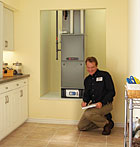
Jim Rutherford prefers to install Trane’s CleanEffects not only because he believes it’s a great solution for IAQ problems, but because he likes how the equipment looks.
Contractors certainly took that statistic to heart and began looking for ways to provide IAQ solutions for homeowners who were suffering from humidity problems, allergies, and dust. Furnace and air conditioner manufacturers were also quick to respond with their own lines of IAQ equipment in order to support their dealers’ demands for total-system solutions.
Homeowners responded positively to these integrated heating-cooling-IAQ systems, and as a result, contractors offering these solutions now enjoy bigger profit margins and happier, more comfortable customers.
FITS TOGETHER PERFECTLY
One of the main reasons why Ben Stark, general manager/owner, Stark Air, Hurst, Texas, enjoys installing Lennox’s Healthy Climate line of IAQ products is that they match perfectly with the manufacturer’s heating and cooling products. “It’s an easy install, and they communicate correctly with like devices. There are no glitches, and the wiring is simple. The nice thing is that the Healthy Climate line also fits perfectly with the other brand we sell, so it is a perfect setup.”Jim Rutherford, president, Total Comfort Inc., Atlanta, enjoys installing Trane’s CleanEffects not only because he believes it’s a great IAQ solution, but knowing it removes up to 99.98 percent of particles and allergens (in the filtered air) down to 0.1 micron, ensures he can exceed the customer’s expectations. “I love putting a CleanEffects on a Trane heating and cooling system. It’s a good-looking system when everything is installed together. And while it works well with Trane equipment, it can also be installed with equipment from any manufacturer.”

Offering whole house solutions that include an IAQ component such as CleanEffects can result in a boost to the bottom line for contractors. (Courtesy of Trane.)
Rutherford agreed that offering whole-house solutions makes sense, especially in today’s market. “Anytime you sell IAQ products or accessories on a replacement sale, it’s going to help your bottom line. But the most important thing to do is find out your customers’ needs. We will evaluate a home, figure out what we need to do as a package, then present that package to the homeowner. The goal for us is a profitable sale, but I want to go in and make these homeowners thrilled with what I do. I want them to be more comfortable than they’ve ever been in their house.”
Happy customers mean more referrals to Rutherford, which results in a never-ending supply of opportunities to grow the business. “If we are able to sell the value of a product like CleanEffects, then we show the customer we can meet their expectations. It helps the bottom line on that job, but it also creates a little bit of a buzz, so that relationship referral sale opportunity helps increase profitability down the road.”

Ben Stark enjoys installing Lennox’s Healthy Climate line of IAQ products because they match perfectly with the manufacturer’s heating and cooling products.
VALUE PROPOSITION
While IAQ is very important to most homeowners, energy savings may be an even bigger issue to customers who are looking to replace their HVAC equipment. The key is to combine the two so the homeowner ends up with the best comfort and value possible, said Stark. “Most contractors just take out an older unit and replace it with a new one of the same size and tell the customer they will save money. The truth of the matter is, they are probably not going to save money because they have not redesigned the duct system or installed a zoning system. With zoning, it is possible to size the system a little bit smaller, which allows customers to get better comfort much more energy efficiently. Add in upgraded filtration, and the house is much cleaner with fewer pollutants.”Educating customers to ensure they understand the value that is added by incorporating an IAQ component into the system is very important to Rutherford as well. “We have a lot of pollen here, so we have changed our sales process to make sure customers understand that we add value with CleanEffects being part of the system. It’s not just taking care of the pollen, it’s keeping the system cleaner than standard filters. It’s going to keep the evaporator coil clean, the blower wheel clean, and it will help the system operate more efficiently because the evaporator coil won’t be loaded up, which affects heat transfer. If we put all those components together and explain that they are all necessary pieces of the system - even though it may be more expensive - it fulfills the value proposition.”
Understanding the value of IAQ equipment is not only important for the customer, it is equally important for the contractor. Stark noted that sales of IAQ equipment comprise approximately 30 percent of his company’s business, and he expects that number to increase. He is especially thankful for his IAQ business during slow times, as that keeps his crew busy year-round.
“When we do a changeout with IAQ, it typically averages between $10,000 and $12,000,” said Stark. “With just IAQ, the average ticket may only be $6,000 or $8,000 with ductwork, but we do a whole lot more of those jobs throughout the year. The key is to prepare yourself, so you’re ready to go when allergy season hits. It pays off very well.”
Publication date:03/22/2010


Report Abusive Comment